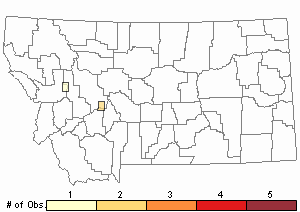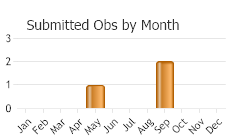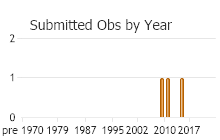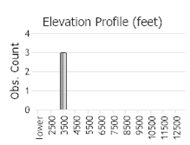View in other NatureServe Network Field Guides
NatureServe
Montana
Utah
Wyoming
Idaho
Wisconsin
British Columbia
South Carolina
Yukon
California
New York
Vancouver Dart Moth - Agrotis vancouverensis
General Description
The Vancouver Dart (
Agrotis vancouverensis) is a medium size moth (forewing length about 33 mm) with light and dark reddish brown forewings. The subterminal area in particular is usually lighter brown, and is crossed by poorly defined jagged light and dark lines. The orbicular and reniform spots are well defined, with the area before and between them blackish. The basal dash-claviform spot is prominent and filled with black scales. The hind wings are brown (LaFontaine 1987).
The larvae are gray with a diffuse dark oval or diamond-shaped patch on the dorsum of each segment. There is a dark gray sub-dorsal line with dark gray shading speckled with white along the sides. The spiracles and cervical shield are black. The head is closely infuscated with black, including both submedian arcs, and a close reticulate pattern (Powell and Opler 2009).
Phenology
Adults of the Vancouver Dart emerge in late spring and early summer. The main flight is in June (LaFontaine 1987).
Diagnostic Characteristics
The Vancouver Dart is very similar to and often confused with A. obliqua, which is slightly larger, darker, and appears less streaky. Specimens of A. vancouverensis and A. obliqua are difficult to separate, and are frequently found misidentified in collections. A. oblique is widely distributed in wet conifer forests at higher elevations in western North America (LaFontaine 1987).
Range Comments
The Vancouver Dart is widely distributed in the wet conifer forests of the Pacific Northwest and is particularly common west of the Cascade Mountains. The moth has a western distribution, and is absent from most of the Great Plains and Great Basin regions. The Vancouver Dart is the most common and most variable species of Agrotis in western North America (LaFontaine 1987).
Observations in Montana Natural Heritage Program Database
Number of Observations: 21
(Click on the following maps and charts to see full sized version)
Map Help and Descriptions
Relative Density

Recency



 (Observations spanning multiple months or years are excluded from time charts)
(Observations spanning multiple months or years are excluded from time charts)
Food Habits
Vancouver Dart larvae feed on low herbacious plants such as
Trifolium (Fabaceae),
Fragaria (Rosaceae), and grass (
Poaceae) (Powell and Opler 2009).
Reproductive Characteristics
The Vancouver Dart is single brooded (Powell and Opler 2009).
Stewardship Responsibility
References
- Literature Cited AboveLegend:
 View Online Publication
View Online Publication Lafontaine, J.D. 1987. Noctuoidea, Noctuidae (Part): Fascicle 27.2: Noctuinae (Part-Euxoa). The Moths of America North of Mexico (Lepidoptera). E. W. Classey Ltd. and R. B. D. Publications, London, England. 237 pp.
Lafontaine, J.D. 1987. Noctuoidea, Noctuidae (Part): Fascicle 27.2: Noctuinae (Part-Euxoa). The Moths of America North of Mexico (Lepidoptera). E. W. Classey Ltd. and R. B. D. Publications, London, England. 237 pp. Powell, J.A. and P.A. Opler. 2009. Moths of Western North America. University of California Press, Berkeley, CA. 369 pp.
Powell, J.A. and P.A. Opler. 2009. Moths of Western North America. University of California Press, Berkeley, CA. 369 pp.
- Web Search Engines for Articles on "Vancouver Dart Moth"
- Additional Sources of Information Related to "Insects"





